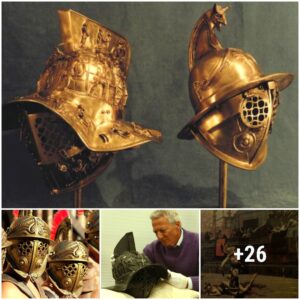In December 1900, the keepers of the Flannan Isles Lighthouse off the northwest coast of Scotland mysteriously disappeared — and to this day, no one knows what happened.
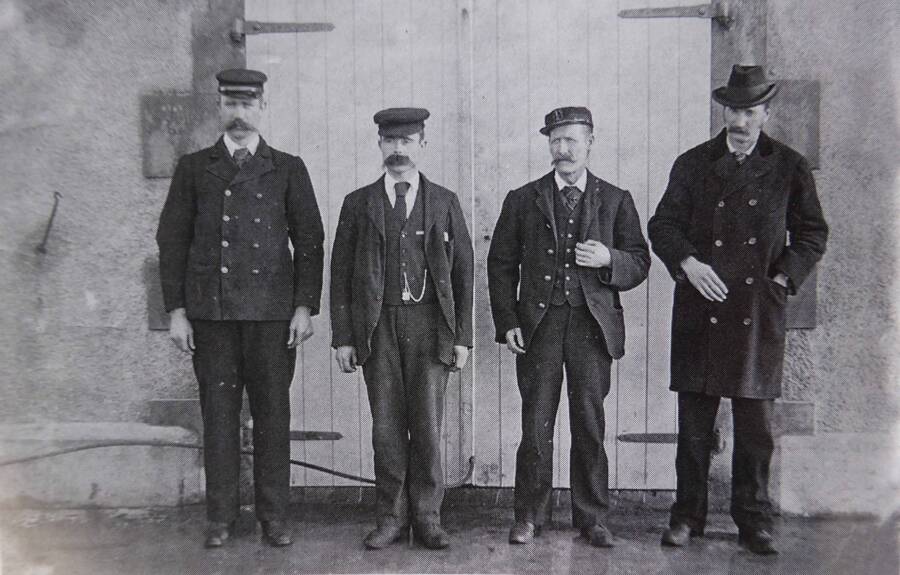

Press and JournalThe three lighthouse keepers who went missing from left to right: Thomas Marshall, James Ducat, and Donald MacArthur. The man on the far right is the lighthouse board superintendent Robert Muirhead, who recruited the men who went missing.
“A dreadful accident has happened at the Flannans,” reported a ship captain in 1900.
After a lighthouse went dark in the wild islands north of Scotland, a ship traveled to the Flannan Isles to investigate. They discovered that all three lighthouse keepers had vanished.
The captain added, “On our arrival there this afternoon no sign of life was to be seen on the Island.”
What happened to the vanished lighthouse keepers? Was the Flannan Isle mystery an accident, or something darker?
Investigating The Flannan Isle Mystery
Three lighthouse keepers – James Ducat, Thomas Marshall, and William MacArthur – manned the remote outpost on Eilean Mòr, one of the Flannan Isles. Built only a year earlier in 1899, the lighthouse was sturdy and sound.
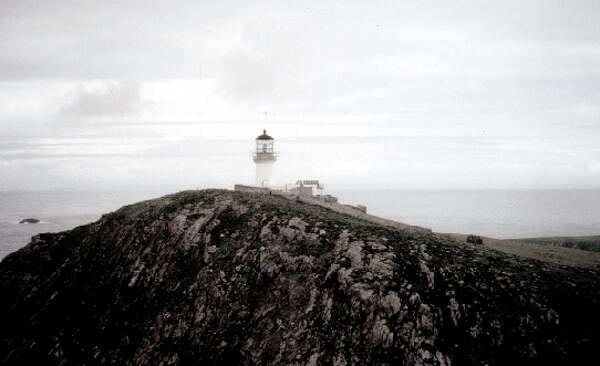

The Eilean Mòr Lighthouse, built in 1899, withstood the storm in 1900 – but somehow, all three lighthouse keepers went missing.
The men likely disappeared around December 15, 1900, about the time a storm had swept across the North Atlantic.
Near the end of December, the ship Hesperus sailed north to investigate under Captain Jim Harvie.
On December 26, 1900, The Hesperus docked at the bottom of a steep cliff. Alone, relief lighthouse keeper Joseph Moore climbed the 160 steps up to the lighthouse. When he opened the door, Moore discovered a scene frozen in time.
The clock on the wall stood silent. The table was set, waiting for men who would never return.
Moore found only one living creature at the lighthouse – a canary who sat quietly in a cage.
“I did not take time to search further, for I only too well knew something serious had occurred,” Moore later reported. “I darted out and made for the landing.”


Chris Downer/Wikimedia CommonsSteep stone stairs, carved into the edge of the cliff, led from the landing area up to the lighthouse.
At the Hesperus, Moore reported what he’d found. Two more sailors joined the search for the missing men. But the investigation only deepened the Flannan Isle mystery.
In the lighthouse, the searchers discovered an oilskin, protection against the rough northern weather, meaning one of the lighthouse keepers must have run from the lighthouse during the storm without his rain gear.
On the western side of the isle, the storm’s power left its mark. Iron railings had bent in the wind. A railway track was torn away from the concrete. An enormous boulder had rolled out of place. And a supply box lay smashed on the ground, with its contents spread across the rocky land.
But there was no sign of the three vanished men.
“Poor fellows, they must been blown over the cliffs or drowned trying to secure a crane or something like that,” declared Captain Harvie in his report to the Northern Lighthouse Board.
In his telegram report, the captain also noted, “Nothing appears touched at East landing to show that they were taken from there. On West side it is somewhat different. We had an old box halfway up the railway for holding West landing mooring ropes and tackle, and it has gone.”
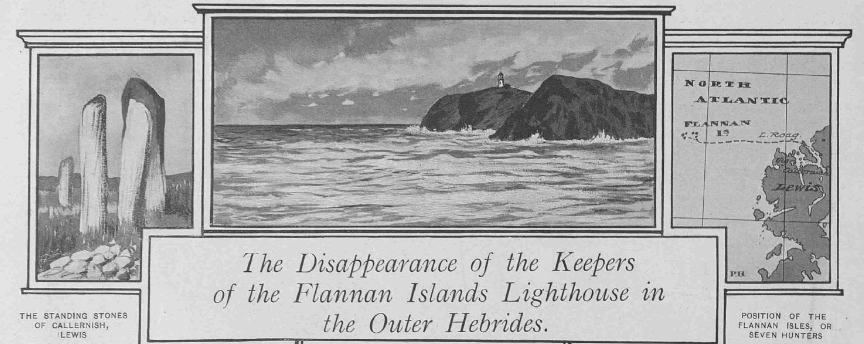

The SphereIn January 1901, a British newspaper reported on the Flannan Isle mystery, noting the disappearance of the lighthouse keepers.
Was the west landing where the men died? “Now there is nothing to give us an indication that it was there the poor men lost their lives,” the captain warned.
Robert Muirhead, the lighthouse board superintendent, had personally recruited the three missing men. He traveled to the Flannan Isles to conduct his own investigation.
The Official Report And Surrounding Rumors
Muirhead declared that the Flannan Isle mystery was merely an accident. In his official report, Muirhead stated that two men had traveled to the west landing around dinner time on December 15. They hoped to secure ropes and the supply box.
“An extra large sea had rushed up the face of the rock,” Muirhead speculated, “had gone above them, and coming down with immense force, had swept them completely away.”
Wind could not have been the cause, Muirhead reasoned, because the direction of the wind would have pushed the men toward the island rather than out to sea.
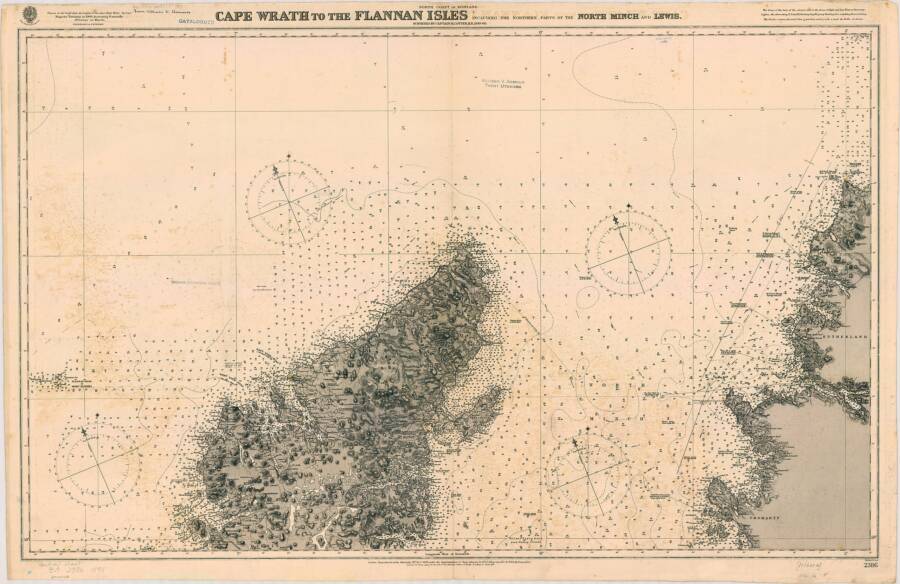

United Kingdom Hydrographic OfficeAn 1898 chart of the Flannan Isles, at the far left, shows the importance of the lighthouse on the rocky outcroppings.
The official report did not end speculation. Along the windswept islands of the Hebrides, some blamed a sea serpent for devouring the men. Others claimed the keepers had tried to escape the island only to be swept away.
Another theory claimed that a fight had broken out. One of the keepers killed another. While covering up the crime, the survivors were swept out to sea. Or did MacArthur, known for his short temper, kill both men and throw himself off the cliffs?
In the years after their tragic disappearance, the rumors surrounding the lighthouse keepers only intensified.
Stories of a logbook containing suspicious entries began to surface. In this supposed logbook, Marshall had written about their despair during the storm, praying for protection before it finally ended on December 15.
But if the storm had ended before the men disappeared, it seemed foul play was much more likely than previously thought.
However, no evidence of these logbook entries has ever surfaced. Official reports at the time show the final entry in the lighthouse log being made on December 13, with small notes about the weather being made on the morning of December 15.
The Unsolved Mystery of the Flannan Isles
The bodies of the missing lighthouse keepers were never found. For over 120 years, the mystery has remained unsolved.


Deseret Evening NewsA Utah newspaper declared the Flannan Isle lighthouse the “most lonely lighthouse” after the tragedy.
Whether an accident or something worse, the disappearance was a tragedy. The men left behind families who never learned the truth. Muirhead also found himself reeling after the deaths.
“I visited Flannan Islands when the relief was made so lately as 7th December, and have the melancholy recollection that I was the last person to shake hands with them and bid them adieu,” Muirhead recalled.
Did a storm or a large wave kill the missing lighthouse keepers? Or did violence claim their lives? Over a century later, we may never learn the true story.
The Flannan Isle mystery remains unsolved. Next, learn about the mystery of the Isdal Woman, a suspected spy – and murder victim – found in Norway in the 1970s. Then, try to unravel the greatest mysteries in history.


